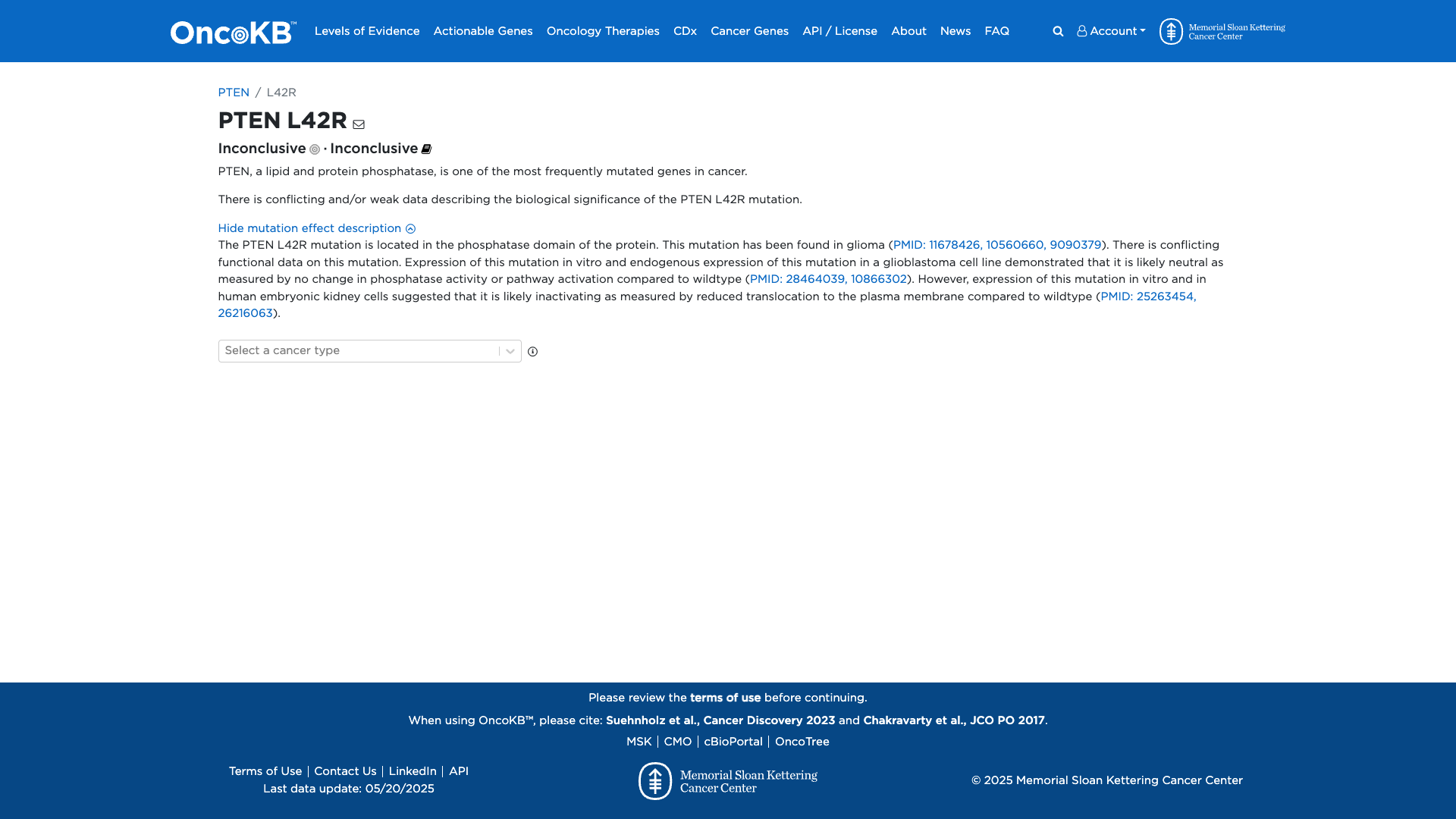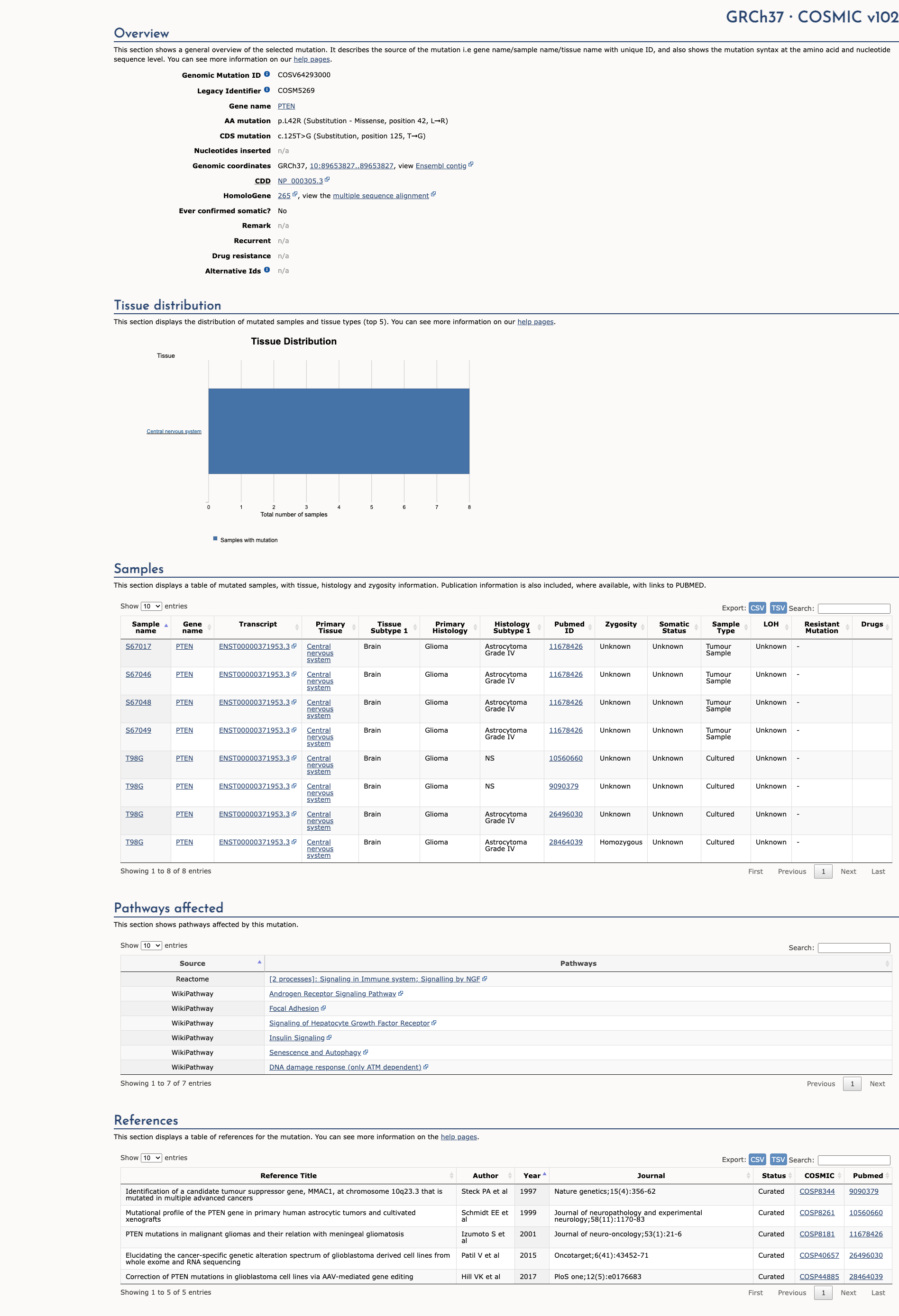PTEN c.125T>G, p.Leu42Arg
NM_000314.8:c.125T>G
COSMIC ID: COSM5269
Variant of Uncertain Significance (VUS)
This variant is classified as VUS because only three criteria (PS3_Moderate, PM2_Supporting, PP3_Supporting) are met, which is insufficient for a Likely Pathogenic classification and no benign criteria are met.
ACMG/AMP Criteria Applied
PS3
PM2
PP3
Genetic Information
Gene & Transcript Details
Gene
PTEN
Transcript
NM_000314.8
MANE Select
Total Exons
9
Strand
Forward (+)
Reference Sequence
NC_000010.10
Alternative Transcripts
| ID | Status | Details |
|---|---|---|
| NM_000314.7 | RefSeq Select | 9 exons | Forward |
| NM_000314.5 | Alternative | 9 exons | Forward |
| NM_000314.4 | Alternative | 9 exons | Forward |
| NM_000314.3 | Alternative | 9 exons | Forward |
| NM_000314.6 | Alternative | 9 exons | Forward |
Variant Details
HGVS Notation
NM_000314.8:c.125T>G
Protein Change
L42R
Location
Exon 2
(Exon 2 of 9)
5'Exon Structure (9 total)3'
Functional Consequence
Loss of Function
Related Variants
No evidence of other pathogenic variants at position 42 in gene PTEN
Alternate Identifiers
COSM5269
Variant interpretation based on transcript NM_000314.8
Genome Browser
Loading genome browser...
HGVS InputNM_000314:c.125T>G
Active Tracks
ConservationRefSeqClinVargnomAD
Navigation tips: Use mouse to drag and zoom. Click on features for details.
Clinical Data
Population Frequency
Global Frequency
0.0 in 100,000
Extremely Rare
Global: 0.0%
0%
0.05%
0.1%
1%
5%
10%+
ACMG Criteria Applied
PM2
This variant is not present in gnomAD (PM2 criteria applies).
Classification
Unknown
Publications (0)
No publication details.
Clinical Statement
Functional Impact
Functional Domain
Hotspot Status
Not a hotspot
Domain Summary
This variant is not located in a mutational hotspot or critical domain (0 mutations).
Related Variants in This Domain
No evidence of other pathogenic variants at position 42 in gene PTEN
Functional Summary
The PTEN L42R variant has conflicting functional evidence. While some studies indicate that it retains phosphatase activity comparable to the wild-type, other studies show reduced membrane localization due to impaired lipid binding. This impaired localization results in an inability to prevent Akt signaling, cell proliferation, and migration, suggesting a loss of function.
Database Previews
OncoKB

JAX-CKB

Click on previews to view full database entries. External databases may require institutional access.
Computational Analysis
Pathogenicity Predictions
REVEL Score
0.927
0.927
Likely Benign0.0
Uncertain (Low)0.2
Uncertain (Med)0.5
Likely Pathogenic0.75
REVEL scores ≥ 0.75 are strong evidence (PP3)
Predictor Consensus
Pathogenic
PP3 Applied
Yes
Additional Predictors
Pathogenic:
sift: Dpolyphen_prediction: probably_damagingmutationtaster: Dfathmm: Dprovean: Dmetasvm: Dmetalr: Dprimateai: Ddeogen2: D
Benign:
CADD: 5.71mutationassessor: L
VCEP Guidelines
Applied ACMG/AMP Criteria (VCEP Specific) VCEP Guidelines
PVS1
PVS1 (Not Applied) Strength Modified
According to VCEP guidelines, the rule for PVS1 is: "Very Strong: Use PTEN PVS1 decision tree." The evidence for this variant shows: it is a missense change (L42R), not a null variant. Therefore, this criterion is not applied.
PS1
PS1 (Not Applied) Strength Modified
According to VCEP guidelines, the rule for PS1 is: "Strong: Same amino acid change as a previously established pathogenic variant regardless of nucleotide change..." The evidence for this variant shows: there is no previously established pathogenic variant causing the same amino acid change at Leu42. Therefore, this criterion is not applied.
PS2
PS2 (Not Applied) Strength Modified
According to VCEP guidelines, the rule for PS2 is: "Very Strong: Proven de novo occurrences..." The evidence for this variant shows: no de novo data are available. Therefore, this criterion is not applied.
PS3
PS3 (Moderate) Strength Modified
According to PTEN Pre-processing guidelines, the rule/finding for PS3 is: "PS3_Moderate evidence added based on high-confidence functional score (-1.6954) < threshold (-1.11)." The evidence for this variant shows: a functional assay score of -1.6954, meeting the PTEN-specific threshold for damaging effect. Therefore, this criterion is applied at Moderate strength because the functional score meets the PTEN-specific PS3_moderate threshold.
PS4
PS4 (Not Applied) Strength Modified
According to VCEP guidelines, the rule for PS4 is: "Strong: Increased prevalence in affected individuals or proband specificity score 4–15.5." The evidence for this variant shows: no case-control or proband data. Therefore, this criterion is not applied.
PM1
PM1 (Not Applied) Strength Modified
According to VCEP guidelines, the rule for PM1 is: "Moderate: Located in a mutational hotspot and/or critical functional domain (residues 90–94, 123–130)." The evidence for this variant shows: Leu42 is outside defined hotspot residues. Therefore, this criterion is not applied.
PM2
PM2 (Supporting) Strength Modified
According to VCEP guidelines, the rule for PM2 is: "Supporting: Absent in population databases at <0.00001 allele frequency." The evidence for this variant shows: MAF=0%, not found in gnomAD. Therefore, this criterion is applied at Supporting strength because the variant is absent from population databases.
PM3
PM3 (Not Applied) Strength Modified
According to standard ACMG guidelines, the rule for PM3 is: "Moderate: For recessive disorders, detected in trans with a pathogenic variant, or homozygous occurrence." The evidence for this variant shows: PTEN is associated with an autosomal dominant disorder and no trans or homozygous data are available. Therefore, this criterion is not applied.
PM4
PM4 (Not Applied) Strength Modified
According to VCEP guidelines, the rule for PM4 is: "Moderate: Protein length changes due to in-frame insertions/deletions in non-repeat region." The evidence for this variant shows: it is a single amino acid substitution, not an in-frame indel. Therefore, this criterion is not applied.
PM5
PM5 (Not Applied) Strength Modified
According to VCEP guidelines, the rule for PM5 is: "Moderate: Missense change at a residue where a different missense change is known pathogenic, with BLOSUM62 score requirement." The evidence for this variant shows: no other pathogenic missense at Leu42 is reported. Therefore, this criterion is not applied.
PM6
PM6 (Not Applied) Strength Modified
According to VCEP guidelines, the rule for PM6 is: "Moderate: Assumed de novo without confirmation of maternity/paternity." The evidence for this variant shows: no de novo data. Therefore, this criterion is not applied.
PP1
PP1 (Not Applied) Strength Modified
According to VCEP guidelines, the rule for PP1 is: "Supporting: Co-segregation in 3–4 meioses; Moderate: in 5–6 meioses; Strong: ≥7 meioses." The evidence for this variant shows: no segregation data. Therefore, this criterion is not applied.
PP2
PP2 (Not Applied) Strength Modified
According to standard ACMG guidelines, the rule for PP2 is: "Supporting: Missense variant in gene with low rate of benign missense variation and where missense is common disease mechanism." The evidence for this variant shows: insufficient data to confirm a low benign missense variation rate in PTEN. Therefore, this criterion is not applied.
PP3
PP3 (Supporting)
According to VCEP guidelines, the rule for PP3 is: "Supporting: Multiple lines of computational evidence support deleterious effect; Missense variants: REVEL score > 0.7." The evidence for this variant shows: REVEL score 0.93 (>0.7) and other tools predict deleterious effect. Therefore, this criterion is applied at Supporting strength because computational predictions strongly support a deleterious effect.
PP4
PP4 (Not Applied) Strength Modified
According to standard ACMG guidelines, the rule for PP4 is: "Supporting: Patient phenotype or family history highly specific to a disease with a single genetic etiology." The evidence for this variant shows: no phenotype or family history data. Therefore, this criterion is not applied.
PP5
PP5 (Not Applied) Strength Modified
According to standard ACMG guidelines, the rule for PP5 is: "Supporting: Reputable source reports variant as pathogenic without evidence." The evidence for this variant shows: no such entries. Therefore, this criterion is not applied.
BA1
BA1 (Not Applied) Strength Modified
According to VCEP guidelines, the rule for BA1 is: "Stand Alone: gnomAD allele frequency >0.00056." The evidence for this variant shows: MAF=0%. Therefore, this criterion is not applied.
BS1
BS1 (Not Applied) Strength Modified
According to VCEP guidelines, the rule for BS1 is: "Strong: Filtering allele frequency 0.000043–0.00056." The evidence for this variant shows: MAF=0%. Therefore, this criterion is not applied.
BS2
BS2 (Not Applied) Strength Modified
According to VCEP guidelines, the rule for BS2 is: "Strong: Observed homozygous in a healthy individual." The evidence for this variant shows: no homozygous observations. Therefore, this criterion is not applied.
BS3
BS3 (Not Applied) Strength Modified
According to VCEP guidelines, the rule for BS3 is: "Strong: Functional studies show no damaging effect." The evidence for this variant shows: functional studies indicate a damaging effect. Therefore, this criterion is not applied.
BS4
BS4 (Not Applied) Strength Modified
According to VCEP guidelines, the rule for BS4 is: "Strong: Lack of segregation in two or more families." The evidence for this variant shows: no segregation data. Therefore, this criterion is not applied.
BP1
BP1 (Not Applied) Strength Modified
According to standard ACMG guidelines, the rule for BP1 is: "Supporting: Missense in gene where truncating variants cause disease." The evidence for this variant shows: PTEN disease mechanism includes missense variants. Therefore, this criterion is not applied.
BP2
BP2 (Not Applied) Strength Modified
According to VCEP guidelines, the rule for BP2 is: "Supporting: Observed in trans with a pathogenic variant or in cis with multiple pathogenic PTEN variants." The evidence for this variant shows: no such observations. Therefore, this criterion is not applied.
BP3
BP3 (Not Applied) Strength Modified
According to standard ACMG guidelines, the rule for BP3 is: "Supporting: In-frame indel in repetitive region without functional impact." The evidence for this variant shows: it is a missense substitution, not an indel. Therefore, this criterion is not applied.
BP4
BP4 (Not Applied) Strength Modified
According to VCEP guidelines, the rule for BP4 is: "Supporting: Computational evidence suggests no impact; Missense variants: REVEL < 0.5." The evidence for this variant shows: REVEL score 0.93. Therefore, this criterion is not applied.
BP5
BP5 (Not Applied) Strength Modified
According to VCEP guidelines, the rule for BP5 is: "Supporting: Variant found in a case with an alternate molecular basis for disease." The evidence for this variant shows: no alternate molecular basis reported. Therefore, this criterion is not applied.
BP6
BP6 (Not Applied) Strength Modified
According to standard ACMG guidelines, the rule for BP6 is: "Supporting: Reputable source reports variant as benign without evidence." The evidence for this variant shows: no such reports. Therefore, this criterion is not applied.
BP7
BP7 (Not Applied) Strength Modified
According to VCEP guidelines, the rule for BP7 is: "Supporting: Silent or intronic variant at or beyond ±7/–21 with no splicing impact." The evidence for this variant shows: it is a missense variant. Therefore, this criterion is not applied.

